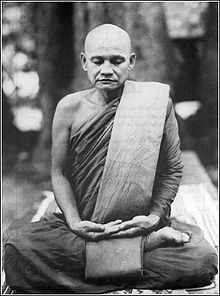Chah Subhatto
| Phra Bodhiñāṇathera (Chah Subaddho) |
|
|---|---|
 |
|
| School | Theravada, Maha Nikaya |
| Other names | Luang Por Chah (หลวงพ่อชา), Luang Pu Chah (หลวงปู่ชา), Ajahn Chah (อาจารย์ชา), Chao Khun Bodhinyana Thera (เจ้าคุณโพธิญาณเถระ) |
| Dharma names | Subhaddo |
| Personal | |
| Nationality | Thai |
| Born |
17 June 1918 Ubon, Thailand |
| Died | 16 January 1992 (aged 73) Ubon, Thailand |
| Senior posting | |
| Title | Phra Bodhiñanathera (1973) |
| Religious career | |
| Teacher | Ven. Ajahn Mun Bhuridatta, Ven. Ajahn Thongrat, Ven. Ajahn Kinaree |
| Students | Ajahn Brahm, Ajahn Sumedho |
| Website | ajahnchah.org watnongpahpong.org watpahnanachat.org |
Chah Subhaddo (Thai: ชา สุภัทโท, alternatively Achaan Chah, occasionally with honorific titles Luang Por and Phra) or in honorific name "Phra Bodhiñāṇathera" (Thai: พระโพธิญาณเถร,Chao Khun Bodhinyana Thera; 17 June 1918 – 16 January 1992) was an influential teacher of the Buddhadhamma and a founder of two major monasteries in the Thai Forest Tradition.
Respected and loved in his own country as a man of great wisdom, he was also instrumental in establishing Theravada Buddhism in the West. Beginning in 1979 with the founding of Cittaviveka (commonly known as Chithurst Buddhist Monastery) in the United Kingdom, the Forest Tradition of Ajahn Chah has spread throughout Europe, the United States and the British Commonwealth. The dhamma talks of Ajahn Chah have been recorded, transcribed and translated into several languages.
More than one million people, including the Thai royal family, attended Ajahn Chah's funeral in January 1993 held a year after his death due to the "hundreds of thousands of people expected to attend". He left behind a legacy of dhamma talks, students, and monasteries.
Ajahn Chah was born on 17 June 1918 near Ubon Ratchathani in the Isan region of northeast Thailand. His family were subsistence farmers. As is traditional, Ajahn Chah entered the monastery as a novice at the age of nine, where, during a three-year stay, he learned to read and write. He left the monastery to help his family on the farm, but later returned to monastic life on 16 April 1939, seeking ordination as a Theravadan monk (or bhikkhu). According to the book Food for the Heart: The Collected Writings of Ajahn Chah, he chose to leave the settled monastic life in 1946 and became a wandering ascetic after the death of his father. He walked across Thailand, taking teachings at various monasteries. Among his teachers at this time was Ajahn Mun, a renowned meditation master in the Forest Tradition. Ajahn Chah lived in caves and forests while learning from the meditation monks of the Forest Tradition. A website devoted to Ajahn Chah describes this period of his life:
...
Wikipedia
